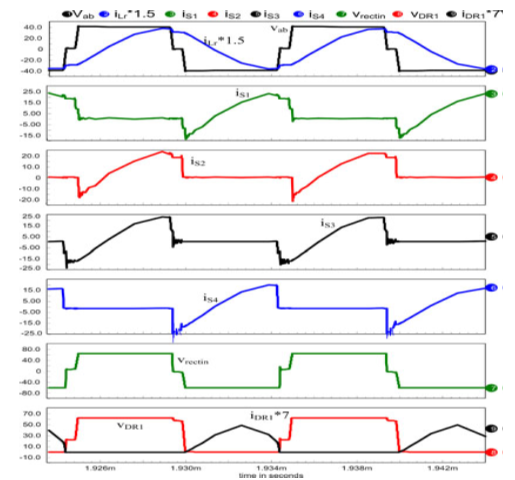A Comparison of Soft-Switched
DC-to-DC Converters for Electrolyzer Application
ABSTRACT:
An electrolyzer is part of a renewable energy system
and generates hydrogen from water electrolysis that is used in fuel cells. A
dc-to-dc converter is required to couple the electrolyzer to the system dc bus.
This paper presents the design of three soft-switched high-frequency
transformer isolated dc-to-dc converters for this application based on the
given specifications. It is shown that LCL-type series resonant
converter (SRC) with capacitive output filter is suitable for this application.
Detailed theoretical and simulation results are presented. Due to the wide variation
in input voltage and load current, no converter can maintain zero-voltage
switching (ZVS) for the complete operating range. Therefore, a two-stage
converter (ZVT boost converter followed by LCL SRC with capacitive
output filter) is found suitable for this application. Experimental results are
presented for the two-stage approach which shows ZVS for the entire line and
load range.
KEYWORDS
1.
DC-to-DC
converters
2.
Electrolyzer
3.
Renewable energy system (RES)
4.
Resonant converters
SOFTWARE: MATLAB/SIMULINK
BLOCK DIAGRAM:
Fig.1.Two-stage
boost-LCL SRC with capacitive output filter.
EXPECTED SIMULATION RESULTS:
Fig.2.
Simulation waveforms for LCL SRC with capacitive output filter at full-load
(2.4 kW) with Vin = 40V and Vo
= 60V: inverter output
voltage vab ; current through
resonant tank inductor iLr ;
switch currents (iS1 –iS4 );
rectifier input voltage (vrectin );
voltage across and current through output rectifier diode DR1 .
Fig.3.
Simulation waveforms of Fig. 13 repeated for LCL SRC with capacitive output
filter at 10% load with Vin = 40V
and Vo = 60V.
CONCLUSION:
A
comparison of HF transformer isolated, soft-switched, dc to- dc converters for
electrolyzer application was presented. An interleaved approach with three
cells (of 2.4kWeach) is suitable for the implementation of a 7.2-kW converter.
Three major configurations designed and compared are as follows: 1) LCL SRC
with capacitive output filter; 2) LCL SRC with inductive output filter;
and 3) phase-shifted ZVS PWM full-bridge converter. It has been shown that LCL
SRC with capacitive output filter has the desirable features for the
present application. Theoretical predictions of the selected configuration have
been compared with the SPICE simulation results for the given specifications. It
has been shown that none of the converters maintain ZVS for maximum input
voltage. However, it is shown that LCL-type SRC with capacitive output
filter is the only converter that maintains soft-switching for complete load
range at the minimum input voltage while overcoming the drawbacks of inductive
output filter. But the converter requires low value of resonant inductor Lr for
low input voltage design. Therefore, it is better to boost the input voltage
and then use the LCL SRC with capacitive output filter as a second
stage. When this converter is operated with almost fixed input voltage, duty
cycle variation required is the least among all the three converters while
operating with ZVS for the complete variations in input voltage and load. A ZVT
boost converter with the specified input voltage (40–60 V) will generate
approximately 100V as the input to the resonant converter for Vo = 60V. Therefore, we have
investigated the performance of a ZVT boost converter followed by the LCL
SRC with capacitive output filter. It was shown experimentally that the
two-stage approach obtained ZVS for all the switches over the complete
operating range and also simplified the design of resonant converter.
REFERENCES:
[1]
A. P. Bergen, “Integration and dynamics of a renewable regenerative hydrogen fuel
cell system,” Ph.D. dissertation, Dept. Mechanical Eng., Univ. Victoria,
Victoria, BC, Canada, 2008.
[2]
D. Shapiro, J. Duffy, M. Kimble, and M. Pien, “Solar-powered regenerative PEM
electrolyzer/fuel cell system,” J. Solar Energy, vol. 79, pp. 544–550,
2005.
[3]
F. Barbir, “PEM electrolysis for production of hydrogen from renewable energy
sources,” J. Solar Energy, vol. 78, pp. 661–669, 2005.
[4]
R. L. Steigerwald, “High-frequency resonant transistor DC-DC converters,” IEEE
Trans. Ind. Electron., vol. 31, no. 2, pp. 181–191, May 1984.
[5]
R. L. Steigerwald, “A Comparison of half-bridge resonant converter topologies,”
IEEE Trans. Power Electron., vol. 3, no. 2, pp. 174–182, Apr. 1988.


